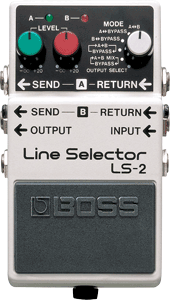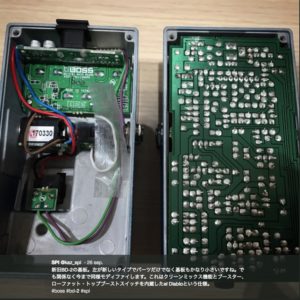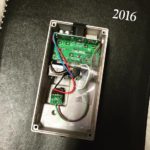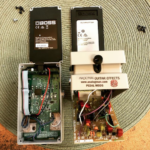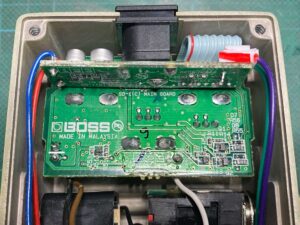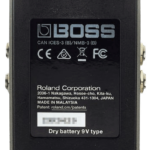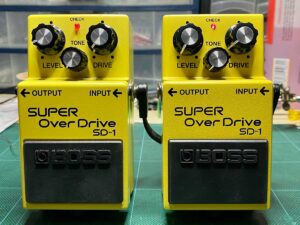There’s a saying that the only two things that will survive a nuclear strike are cockroaches and Boss pedals. And all joking aside, there is some truth to that. The design of the Boss compact pedal has proven itself to be extremely rugged and durable, no doubt at least in part due to the decisions made right from the beginning to minimize the direct contact between the circuit board and the outside world. The footswitch is connected with wires, rather than being soldered straight to the board. The same for the jacks and pots, which are also secured to the box. This means that outside forces – a singer stepping on the plug going into the pedal, or a lead-footed guitar player stomping on the pedal – will not reach the main circuit board. The only vulnerable point is the adapter jack – specifically the type that is soldered to the circuit board, poking out through a square cutout in the box – since that is the only point of contact between the board and the outside world. But other than that, as long as the box itself isn’t crushed, the pedal will usually survive whatever is thrown at it (or being thrown at things). And since they mostly used regular-sized through-hole components, they were quite easy to repair, in the rare event that something did go wrong.
But all things must pass, as they say. In the last few years, some of Boss’ existing pedal designs have received a complete (internal) make-over, with all new circuit board layouts using small surface-mounted components. This is of course an advantage when it comes to production costs, but a distinct disadvantage when it comes to repairs and modifications. Very few people are inclined to repair (or modify) circuits with this type of construction, so this development is a blow to those of us who do that sort of thing. When I first posted this article, it was just a couple of pedals, and I wanted to lay out the differences to help people spot which , as and when new versions of pedals appeared. However, it has become increasingly clear that Boss have accelerated the shift (of older designs) to the new format, so this article will now serve more as an overview of the situation. Instead I wrote a separate ”under the hood” article about the new SD-1, to delve a little deeper into that one specifically.
The new design brief
Boss has maintained roughly the same basic construction layout since the first compact pedals appeared in 1978, with a circuit board that spans the majority of the pedal’s footprint. The picture to the right shows an SD-1 Super Overdrive, for reference. In later designs, Boss extended the circuit board to cover the entire footprint, in order to mount the adapter jack directly to the board. Most of them have until now used through-hole components, apart from some of the more complex digital delays etc.
The new design brief has a much smaller main circuit board, which in most cases only covers the upper section (above the jacks). Obviously, to be able to do this, the designers at Boss had to use some of the very smallest surface-mounted components, as well as double-sided circuit boards (possibly with a middle layer of circuit traces as well). To the left is a picture (found on Instagram from what I believe is a Japanese user – if it is yours, and you want to be credited or want me to take it down, let me know) of the new and old BD-2 Blues Driver.
Now, this may not be the new overall design brief for all (new) Boss pedals – they have released new designs post 2016 (SY-1, RE-2, DD-3T etc) that have used the same basic design as before, with a circuit board that covers the entire footprint of the pedal. So time will tell if this new style is something they have done to make the existing pedals a little cheaper to produce, or if this is the way forward.
Thankfully, even though the pots now are mounted directly to the main circuit board, they are also properly secured to the box. And the jacks are the same way – soldered to their own circuit boards, but still secured to the box. So these pedals should be just as bullet-proof as the older designs, which is good. I’m happy that Boss at least didn’t go the Behringer/Ibanez 10 series route, with unsupported jacks/pots…
Which pedals are we talking about, then?
- The DS-1 was the first to appear in this new form, and was spotted as early as 2016 by Analogman. The new one is called DS-1(B), and is (or was, at the time of writing) made in Taiwan.
The DS-1 first appeared in 1978, and stayed largely the same until 1994. At that time, the DS-1(A) was born, sporting a different op-amp chip which forced a slightly redesigned circuit. The adapter jack was moved to the circuit board and the circuit was changed to PSA (regulated 9vDC) specs. From there on, the DS-1 only underwent tiny changes – both in 2000 and 2006 the op-amp chip was changed – but the main circuit stayed the same, even the 40th Anniversary model. Until now, that is.
- Next up was the BD-2 Blues Driver – internally at Boss (and on the circuit board) named BD-2(B) – which appeared mid 2017. It is pictured above, for reference. I first thought the Blues Driver was too recent to warrant a redesign, until I realized that it has been around since 1995. Apparently it’s me that’s getting old, thinking that 1995 qualifies as ”recent” 😀 Anyway, the early revised BD-2(B) models may have been made in Taiwan, but recent ones are definitely made in Malaysia.
- Some time later, the SD-1 Super Overdrive appeared in its new form. This one is named SD-1(C) – don’t ask me why Boss skipped the ”B”. I bought one to investigate if it would at all be possible to modify it. The answer (my answer, at least) was no… The components are tiny – some less than a mm wide – and quite close together. So I won’t be touching these with a soldering iron, sadly.
Anyway, I did find some things out, and am working on an ”under the hood” article on it. I can reveal that the ”bleed” issue (read about it here) is finally fixed – at least one good thing to come out of the new design! Mine is made in Malaysia, btw.
- The new GE-7 Equalizer is made in Malaysia, and I don’t know the internal name. I doubt it has a ”B” added to it, though, since there already is a GE-7B (the bass version) around. So it might be a ”C” instead. Anyway… this one has a slightly different layout. The power/switching board is the same, but in this one the main board is quite a bit larger. This is most likely due to the EQ sliders taking up so much room on the board. In the old GE-7, they were soldered to a separate board, mounted underneath the main board. In this new one, though, everything is on the same plane.
I was hoping that the redesigned GE-7 would at least have cleared up the original’s main problem – copious amounts of hiss, mainly due to the use of some really old op-amps. I have seen modern versions of the same circuits (for instance the Danelectro Fish&Chips as well as the Behringer EQ700), which have been dead quiet, simply by virtue of the use of more modern less noisy components. And from some reports I’ve read, the new Boss GE-7 circuit seems to be far quieter as well. Other reports say the noise (or at least enough to be irritating) is still there, so the jury is still out on this one.
- The TR-2 Tremolo has already had one previous redesign. In mid 2006, to get it RoHS certified, they had to start using a different op-amp, which forced a slight redesign of that part of the circuit. At that time, they also raised the output gain slightly, to help with the volume loss issue that plagued the first iteration of the pedal. Some of those also have a trimpot inside, where you can set the output level.
The new version seems to have a slightly different layout than most of the other new versions – the main board has the input jack soldered to it, and extends from there towards the heel end of the enclosure. There’s also a control board that carries the pots, and probably (it wasn’t visible it in the few pictures I’ve seen thus far) also a power board like the others have. There is a trimpot on the main board to set the output level, which is useful, since modifying it probably won’t be on the cards. Again, I’m not aware of the internal name – if there’s a (B) or (C) at the end of the ”TR-2”. But it is made in Malaysia, at least.
- And they keep coming… During a recent visit to my local music store (Uppsala Musikverkstad, if you’re wondering), I took a quick peek at some of the Boss pedals on display. I didn’t go trough all of them, but I did definitely spot an OD-3 Overdrive and an OS-2 Overdrive/Distortion of the new variety, as well as (I think) an MT-2 Metal Zone. I suspect there are more to come…
So what does it all mean?
For those of us who want to mod pedals – or have them modded for us – this change is not so good. Yes, it can still be done, technically. The circuit is still there, and can be changed the same way as before. But you will need a really big magnifying glass and an extremely stable hand, to replace these tiny components. Surface-mount components come in all sorts of different sizes, and Boss has chosen some of the very smallest ones. So small that even seeing the numbers (to determine what kind of component it is, and its value) is really hard. And I haven’t seen any service manuals for these ”(B)” versions leak out on the internet yet, so identifying individual parts of the circuit will not be easy. Finally, adding off-board components (such as different clipping diode options on a switch) will be much harder to do. Thus, I suspect most modders will take a pass on these. And the same goes for repairs, sadly. While Boss compacts have a reputation for being sensationally sturdy, even they will sometimes fail – not least by the hands of owners who accidentally use the wrong power adapter 🙂 And while fixing pedals damaged that way used to be quite simple, it will be much harder with these new designs.
How do I know which is which?
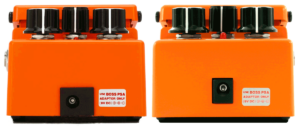
Many of the new design pedals can be easily identified from the outside, since the adapter jack is the old ”external” style – the type that sits partly on the outside, rather than poke through a cutout in the box. The pic to the right shows two different DS-1 pedals – to the left, the new DS-1(B) and to the right the DS-1(A). On some Boss models, the internal jack type is slightly wider/more square, but they still count as ”internal” (since they are board mounted).
If you spot a pedal with the ”external” type jack and a PSA sticker, it will be one of the new ones. Except for the SD-1 – that one has always that that type of jack, so to spot one of those, you’ll need to look elsewhere.
The bottom plate is the next obvious place to look, as the new pedals will have the new label style, shown to the right. Note that the area where for the label is smaller, and there’s no ”Boss” logo embossed in the rubber, as on the earlier style back plate.
But there are also other clues. One thing is the LED, which on the new ones is clear, rather than diffused. You will still see that it is red, but the light shines up from inside it, rather than the entire body lighting up. It also seems to sit a little lower down, so it doesn’t stick up as high above the box surface. You’ll know it when you see it. For reference, there’s a pic of the SD-1(C) LED a little earlier in this article (or click the link).
Yet another thing is the paint – the new pedals I have seen have all had a slight texture to the surface. Again, as with the LED, you’ll know it when you see it, even if it of course will be most obvious with the new and old versions side by side. As it happens, I did take just such a photo. Click to enlarge it, and the differences should be fairly obvious (smooth surface/diffused LED vs textured surface/clear LED). In person, there’s also a slight difference in colour, where the new pedal has a slightly darker/deeper yellow. That can be hard to see, though, unless you can see both types at the same time.
I’ll keep an eye out for more redesigned Boss pedals, and update this page as and when I spot them 🙂
